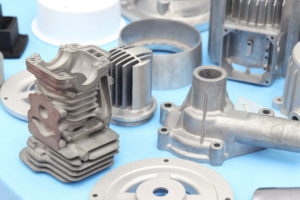The Buzz on Alcast Company
The Buzz on Alcast Company
Blog Article
The Facts About Alcast Company Revealed
Table of Contents4 Simple Techniques For Alcast Company8 Easy Facts About Alcast Company ExplainedSome Of Alcast CompanyWhat Does Alcast Company Mean?Alcast Company Fundamentals ExplainedFascination About Alcast Company
The refined distinction lies in the chemical content. Chemical Contrast of Cast Aluminum Alloys Silicon promotes castability by lowering the alloy's melting temperature level and enhancing fluidness during spreading. It plays a crucial duty in enabling intricate mold and mildews to be filled precisely. In addition, silicon adds to the alloy's stamina and put on resistance, making it useful in applications where resilience is important, such as vehicle components and engine parts.It also boosts the machinability of the alloy, making it much easier to process into finished products. This way, iron adds to the general workability of light weight aluminum alloys. Copper increases electrical conductivity, making it beneficial in electric applications. It likewise improves deterioration resistance and contributes to the alloy's general strength.
Manganese adds to the toughness of aluminum alloys and boosts workability (Aluminum Castings). It is frequently utilized in functioned light weight aluminum products like sheets, extrusions, and accounts. The existence of manganese help in the alloy's formability and resistance to splitting during construction processes. Magnesium is a light-weight aspect that supplies toughness and impact resistance to light weight aluminum alloys.
Get This Report on Alcast Company
It permits the production of light-weight components with outstanding mechanical homes. Zinc enhances the castability of aluminum alloys and helps manage the solidification procedure during spreading. It enhances the alloy's stamina and solidity. It is typically found in applications where complex forms and fine information are needed, such as attractive castings and certain vehicle components.

The key thermal conductivity, tensile stamina, return stamina, and elongation vary. Select ideal basic materials according to the efficiency of the target product produced. Amongst the above alloys, A356 has the highest thermal conductivity, and A380 and ADC12 have the lowest. The tensile limit is the opposite. A360 has the ideal yield toughness and the highest possible elongation rate.
The 4-Minute Rule for Alcast Company

In accuracy casting, 6063 is appropriate for applications where elaborate geometries and high-grade surface finishes are extremely important. Instances include telecommunication units, where the alloy's exceptional formability enables streamlined and visually pleasing styles while keeping architectural integrity. In the Lighting Solutions industry, precision-cast 6063 elements develop sophisticated and reliable lights fixtures that require intricate shapes and great thermal performance.
The A360 exhibits remarkable elongation, making it ideal for complicated and thin-walled parts. In precision casting applications, A360 is appropriate for sectors such as Consumer Electronics, Telecommunication, and Power Tools.
See This Report about Alcast Company
Its unique homes make A360 a official source beneficial option for precision casting in these sectors, enhancing product resilience and high quality. Aluminum Casting. Aluminum alloy 380, or A380, is a commonly used spreading alloy with a number of distinct features.
In accuracy spreading, aluminum 413 radiates in the Consumer Electronics and Power Equipment markets. This alloy's superior deterioration resistance makes it an excellent option for exterior applications, ensuring resilient, long lasting items in the pointed out sectors.
9 Simple Techniques For Alcast Company
The light weight aluminum alloy you choose will significantly impact both the spreading process and the residential properties of the last product. Because of this, you have to make your decision meticulously and take an enlightened method.
Figuring out the most ideal aluminum alloy for your application will mean evaluating a broad range of attributes. The first classification addresses alloy features that affect the production procedure.
How Alcast Company can Save You Time, Stress, and Money.
The alloy you choose for die casting directly influences several elements of the spreading procedure, like just how easy the alloy is to work with and if it is prone to casting defects. Hot breaking, additionally called solidification cracking, is a typical die casting flaw for light weight aluminum alloys that can result in interior or surface-level tears or cracks.
Particular aluminum alloys are more prone to hot fracturing than others, and your selection needs to consider this. It can damage both the actors and the die, so you need to look for alloys with high anti-soldering residential or commercial properties.
Rust resistance, which is currently a significant feature of aluminum, can differ substantially from alloy to alloy and is an important characteristic to consider depending upon the ecological problems your product will certainly be revealed to (Foundry). Wear resistance is one more home frequently sought in light weight aluminum products and can distinguish some alloys
Report this page